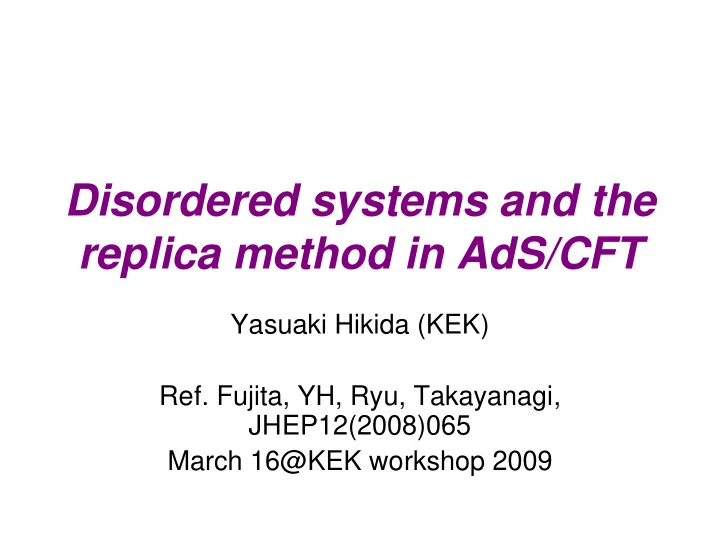

Disordered systems and the replica method in AdS/CFT Yasuaki Hikida (KEK) Ref. Fujita, YH, Ryu, Takayanagi, JHEP12(2008)065 March 16@KEK workshop 2009
1. Introduction
Disordered systems • Impurities Impurities may induce large effects • Disordered systems – Real materials – Spin glass systems – Quantum Hall effects Strongly coupled physics, AdS/CFT correspondence [ Hartnoll-Herzog, Fujita-YH-Ryu-Takayanag
AdS/CFT correspondence [ Maldacena ] • The duality Gravity on ( d+1 )-dim. AdS d -dim. CFT at the boundary z =0 – Partition function [Gubser-Klebanov-Polyakov, Witten ] – Correlation function
Coupling regions • Relation between coupling regions U(N) N =4 4d SYM IIB string on AdS 5 Classical Strongly SUGRA coupled • Strong coupling physics from AdS/CFT – Quark gluon plasma – Strongly correlated physics in condensed matter
Examples of AdS/CMP (I) • AdS superconductor [ Gubser, Hartnoll-Herzog-Horowitz, Maeda-Okamura, Herzog-Kovtun- son, ... ] – Scalar fields can condense near the black hole horizon in AdS space ( � no hair theorem). – In the dual CFT, it can be interpreted as a condensation of cooper pair • High T c superconductur • A second order phase transition, infinite DC conductivity, energy gap, ... • Qauntum Hall effects [ Keski-Cakkuri-Kraus, Davis-Kraus-Shah, Fujita-Li-Ryu-Takayanagi, Hikida-Li-Takayanagi ] – Chern-Simons theory as an effective theory
Examples of AdS/CMP (II) • Non-relativistic CFT – Schrödinger group [Son, Balasubramanian-McGreevy, Sakaguchi-Yoshida, Herzog- Rangamani-Ross, Maldacena-Martelli-Tachikawa, Adams- Balasubramanian-McGreevy, Nakayama-Ryu-Sakaguchi- Yoshida, ... ] • Galilean + Dilatation + Special conformal ( z =2) • Cold atom at criticality (BCS-BEC crossover) – Lifshitz-like model [ Kachru-Liu-Mulligan, Horava, Taylor ] • Time reversal symmetry
Plan of talk 1. Introduction 2. The replica method 3. Field theory analysis 4. Holographic replica method 5. Conclusion 6. Appendix
2. The replica method
Disordered systems • Types of disorder – Annealed disorder • Impurities are in thermal equilibrium. – Quenched disorder • Impurities are fixed. • An example: Random bond Ising model
Set up • Prepare a d -dim. quantum field theory – Ex. U(N) N =4 4d SYM • Perturb the theory by a operator – Ex. a single trace operator The disorder configuration depends on x • Take an average over the disorder
The replica method • Free energy • The replica method – Prepare n copies, take an average, then set n =0
Correlation functions • The effective action Relevant � � Harris criteria • Correlation functions ( cf. the supersymmetric method )
3. Field theory analysis
Set up • Original theory without disorder – d -dim. conformal field theory in the large N limit • Our disordered system – Deform the theory by a singlet operator Harris criteria Unitarity Conformal dimension Higher point functions can be neglected. – n copies of CFT with double trace deformation
Double trace deformation • Perturbation by a double trace operator – A simpler case for an exercise – Beta function One-loop exact in large N limit Non-trivial fixed point
Two point function • Anomalous dimension • RG flow equation
Large N disordered system • Replica theory – n CFTs; CFT 1 ⊗ CFT 2 ⊗ ... ⊗ CFT n – Single trace operators • Double trace deformation Regularization with λ Start with a CFT with deformation λ , then introduce the disorder
RG flow • Flow of couplings • Beta functions
Two pint function • Redefinition of operators • Two point functions 1. In hated basis of replicated theory 2. In the original basis 3. In the limit of Unitrity bound is violated
4. Holographic replica method
AdS/CFT dictionary • The map d -dim. CFT at Gravity on ( d+1 )-dim. AdS the boundary z =0 φ : a scalar field : a spin-less operator m : mass of the scalar BF bound Harris criteria Normalisability Unitarity bound • Boundary behavior at z ∼ 0 – A scalar field satisfying KG eq. and the regularity at z= ∞ Source to Legendre transform
Legendre transform [ Klebanov-Witten ] • Evaluation of action – Start from the ( d+1 ) dim. action for the scalar – Insert the solution and partially integrate over z – Legendre transform
Double trace deformation [ Witten ] • A simpler case with one CFT – Deformation by a double trace operator – The deformed action in the gravity side EOM for β – Two point function reproduces the field theory result
Holographic replica method [ Aharony-Clark-Karch, Kiritsis, Kiritsis-Niarchos • Set up – n CFTs with – n AdS spaces sharing the same boundary • coupled to each other by boundary conditions for φ i • The deformed action in the gravity side EOM for β i
5. Conclusion
Summary and discussions • Summary – Disordered systems and the replica method • Prepare n QFTs, introduce disorder, then take n ->0 limit – RG flow and the two point function • Conformal perturbation theory – Holographic replica method • Multiple AdS spaces coupled though the boundary • Open problems – Quantum disordered system • Dual geometry is AdS black hole – Other quantities • E.g. two point function of currents – Holographic supersymmetric method • OSP(N|N) or U(N|N) supergroup structure
6. Appendix
Beta function • Perturbation from CFT • Shift of cut off length – UV cut off length l is shifted to l (1 + ε ) • Beta function
Anomalous dimension • Perturbation from CFT • Wave function renormalization – Two point function – Shift of UV cut off – Anomalous dimension
Recommend
More recommend